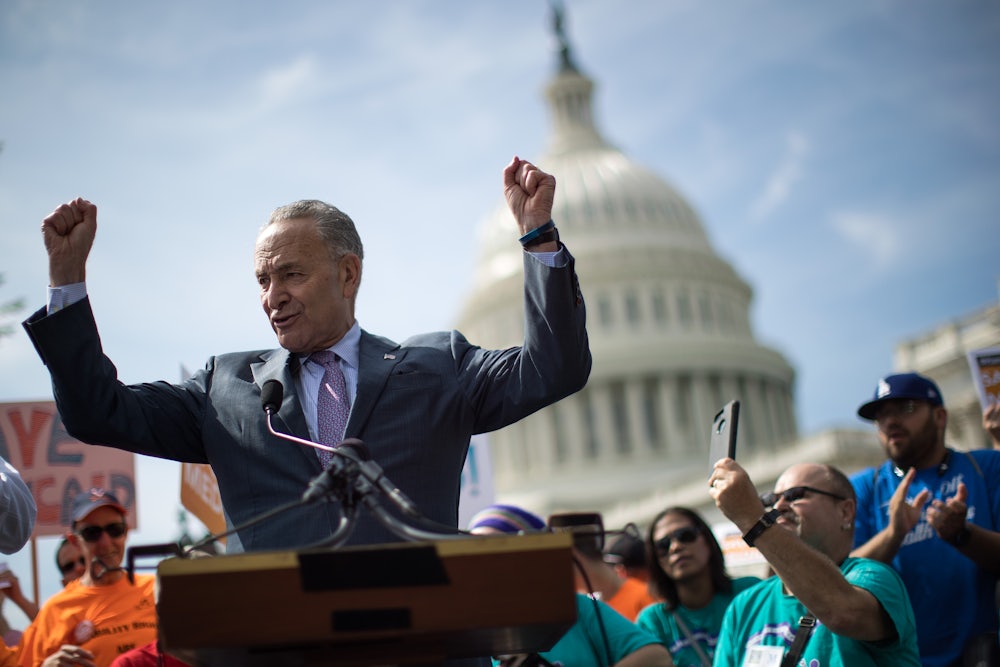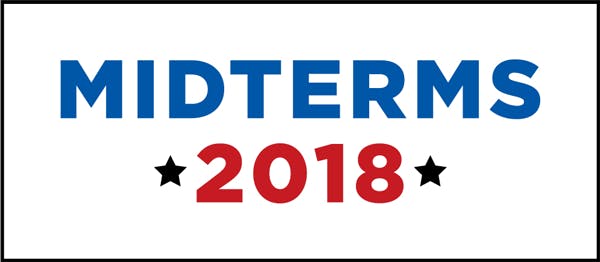In the summer of 2017, when the midterm elections were more than a year away but already on everyone’s mind, Democrats seemed to have an embarrassment of riches.
President Donald Trump was historically unpopular and engulfed in myriad scandals, from the tawdry (an alleged affair with a porn star, covered up with campaign funds) to the corrupt (using the presidency to enrich family businesses) to the existential (Robert Mueller’s investigation into the Trump campaign’s possible collusion with the Russian government to influence the 2016 election). Some of Trump’s cabinet members were similarly engulfed. His White House had become a reality TV psychodrama that not even Bravo’s producers could have dreamed up. And Congress, despite Republicans’ unified control of the government, was failing to accomplish much at all—including its years-long promise to repeal Obamacare.
Presented with so many gifts, Democrats’ only question was whether they should focus on one issue or try to synthesize them all into a single, winning message. “That message is being worked on,” Congressman Joseph Crowley, the number-four Democrat in the House, told the Associated Press. “We’re doing everything we can to simplify it, but at the same time provide the meat behind it as well. So that’s coming together now.”
It did not come together—not then, not ever. The midterms are less than three weeks away. The Democratic Party still hasn’t found its message, and the issues that many thought would feature prominently on the campaign trail—impeachment, Russia, corruption, #MeToo—have largely been relegated to subtext. But somewhere along the way, Democratic candidates around the country, almost in spite of the party’s dithering, have found the winning message themselves.
A year ago, if you were watching cable news—and not following the candidates—the major issues of the campaign would have seemed apparent.
The Russia inquiry had ensnared some of Trump’s top campaign and cabinet officials, including his former chairman, Paul Manafort, and national security adviser, Michael Flynn—both of whom are now convicted felons. And Trump’s firing of FBI Director James Comey suggested a possible attempt at obstructing the Russia investigation.
The president’s corruption, which he only barely seemed to hide, was underscored by the signing of a massive $1.5 trillion tax cut that will greatly benefit him and his family businesses. Trump’s administration, meanwhile, has been marked by ethics scandals and taxpayer waste. Health and Human Services Secretary Tom Price resigned after it was revealed he had spent more than $1 million on private flights, while EPA Administrator Scott Pruitt left the administration after spending hundreds of thousands on first-class travel.
Trump’s record on women—his well-documented history of misogyny, and the many allegations of sexual misconduct against him—was also believed to be a potent election issue, especially since it seemed to be driving the unprecedented number of Democratic women running for office. Kavanaugh’s confirmation battle, which was fractious even before the emergence of allegations of sexual assault, only underlined the GOP’s vulnerability with women.
The number and breadth of these scandals created perhaps the biggest debate in Democratic circles over the past year: whether the party should pin its 2018 hopes on promising to impeach Trump. A few House Democrats support the idea, but party leaders have danced around the question—a recognition, perhaps, that the issue could hurt the party in November. While a significant majority of the party’s base (and megadonor Tom Steyer) support impeachment proceedings, polls consistently show that fewer than half of all Americans do.
Though cool on impeachment, the Democratic Party has repeatedly grasped for a similarly compelling, unified message. Its first attempt, unveiled in July 2017, was the well-conceived, poorly received “A Better Deal,” which stated that the party’s mission was “to help build an America in which working people know that somebody has their back. American families deserve A Better Deal so our country works for everyone again, not just the elites and special interests.” The message went nowhere. Almost exactly a year later, the party rolled out the even more milquetoast “For the people.” Most Democratic lawmakers, if put on the spot today, likely could not explain the three main issues the message represents.
This has led to some familiar Democratic anxiety. Writing in The Atlantic in August, former Democratic Congressman Steve Israel described attending a campaign fundraiser in “a plush residence on the 64th floor of Trump World Tower,” where “most in the crowd wanted to know one thing: What’s the Democratic message?”
“There, in a building staffed with uniformed doormen, standing on floors so fine that we’d been asked to remove our shoes, the donors demanded to know why their party had no unifying theme. Or, more precisely, why wasn’t the message the specific message that they wanted messaged?” he continued. “These questions have come up at Democratic gatherings across the country this year, from grassroots fund-raisers to posh weekend retreats.”
Israel argued that “Democrats have it wrong that they need a national-message template in the first place. Past elections have shown that the most effective messaging is local and specific to each district.” This year’s election seems to be proving this true, or at least Democratic candidates are campaigning as if it is. By and large, they are running on a single issue. It’s not impeachment or collusion or corruption or #MeToo; it’s not even specific to Trump. The election, for many Democrats, is all about health care.
“The top three issues this year are health care, health care, health care,” J.B. Poersch, the head of the Democratic Senate Majority PAC told CNN last week. Candidates across the country, from Cindy Axne in Iowa to Claire McCaskill in Missouri to Josh Harder in California are talking about their own struggles dealing with the high cost of medical care. West Virginia’s Joe Manchin, toe lone Democratic senator to vote to confirm Kavanaugh, is leading in the polls in his state, thanks in large part to his embrace of Obamacare, which he even made an issue during the most recent Supreme Court confirmation.
Republicans are following suit, even those who voted to repeal the Affordable Care Act in 2017. Republican Martha McSally, who is running to fill Jeff Flake’s Arizona Senate seat, has campaigned on protecting coverage for pre-existing conditions, despite voting for the AHCA, which would have repealed the ACA, last year. In a debate on Monday, she told voters, “We can’t go back to where we were before Obamacare.”
Trump’s most significant legislative accomplishment, the $1.5 trillion corporate tax cut passed last December, has also factored into Democratic messaging—partly to highlight the hypocrisy of Republicans’ deficit hysteria during the Obama years, but also as another way to discuss health care.
Journalists and politicians talk about “the health care repeal and the Trump tax plan as two different issues,” Democratic consultant Jesse Ferguson told CNN back in May. But “the voters see them as ways Washington isn’t looking out for them.... On both of them, it’s basically the same: [Republicans] have been giving tax breaks to health insurance companies, to pharmaceutical companies, and those come at the expense of people who work for a living. It means higher health care costs, eventually higher taxes, more debt for your kids, and cuts to Social Security and Medicare as you get older.”
After Mitch McConnell said on Tuesday that entitlement cuts to Medicare, Medicaid, and Social Security are the only way to reduce the deficit, Democrats immediately sent out emails tying his statement to the tax cut.
Heads up for the "Dems have no national message" people: The McConnell comments on entitlements are driving today's state Dem messaging. pic.twitter.com/OzCvauPMax
— Dave Weigel (@daveweigel) October 16, 2018
It’s possible, of course, that Democrats are focusing on these issues in part because they don’t have to draw more attention to the president’s scandals, which already dominate cable news. The party’s fear has long been that its message, whatever it may be on a given day, would be drowned out by all things Trump. But the wall-to-wall coverage of Trump may in fact be helping Democrats. His scandals are now inevitably woven into the fabric of the 2018 campaign, such that Democratic candidates don’t need to go hoarse talking about Mueller or Trump’s tax returns or Stormy Daniels; voters are already motivated one way or another by those matters. Instead, Democrats can spend their time hammering the single issue that Republicans are most vulnerable on—which also happens to be the issue that voters care the most about.

